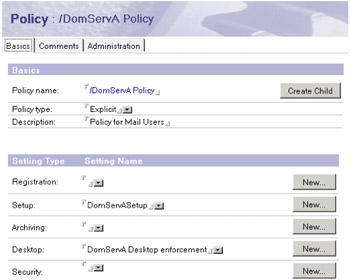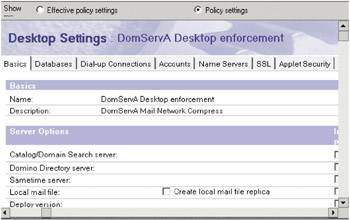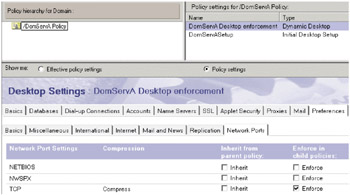8.9 New 6.5 features
|
| < Day Day Up > |
|
8.9 New 6.5 features
The following new features are listed in the Release Notes for 6.5 (readme.nsf file). In regard to the Domino Server specific to serviceability, the following enhancements include:
-
Unify Fault Recovery/CleanupScriptPath interface - simply stated, these features can be set in the server document, as shown in 8.6.3, "Fault recovery" on page 205.
-
Free-running memcheck to validate in-memory data structures (was initially run with nsd; see Example 8-8).
Example 8-8: Free-running memcheck

domserva@linuxa:/domserva/notesdata > memcheck Copyright (c) IBM Corporation 1987, 2003. All Rights Reserved. Usage: memcheck [options] Options: [ -k c*urrent ] -- analyze shared memory using default/current environment [ -k shmkey ] -- analyze shared memory with IPC key 'shmkey' [ -p pid ] -- analyze process 'pid' heap memory [ -c corefile ] -- analyze core file 'corefile' memory [ -f imagedump ] -- analyze memory saved in file 'imagedump' Examples: memcheck -k 0xf8000000 memcheck -p 1251 -p 1255 memcheck -c core memcheck -k 0xf8000000 -p 1254 -d all -o imagedump.out memcheck -f imagedump.out -v2 memcheck -k 0xf8000000 -t 0x4120 # show block type 0x4120 entries only memcheck -k 0xf8000000 -t 0x4100 # show package 0x4100 entries only

-
Timestamps in SEMDEBUG.TXT (Semaphore timeout issues): If a semaphore timeout occurs, this can be reported as SemTimeouts at the console (sh stat sem.timeouts), or you may see the following message: session semaphore held for [n] seconds. Technical Support will request that you capture the text file containing the semaphores. Previously there was no way of telling the date or time; that has been changed in this release.
The new features listed in Table 8-8 on page 212 are derived from the Administration Help database (help65_admin.nsf).
| New Feature | Description | For more information |
|---|---|---|
| Server setup and installation New scriptable client setup variables | When setting up Notes with a scriptable setup, you can now include Sametime configuration variables in that setup. Notes users can then configure Sametime for use within their Notes client. | See the topic Setting up Notes with a scriptable setup. |
| Server.Load New SendMessage profile command for Server.Load | The SendMessage profile command creates and sends messages of varying sizes according to a pre-established set of sizes and distribution percentages | See the topic SendMessage command and SendMessage profile command |
| Server Monitoring Support for platform statistics for Domino on Linux for zSeries and Linux | Platform statistics are now supported for Linux and for Linux on zSeries. You can now view, control the reporting of Linux platform statistics, collect statistics, and perform other statistics-related tasks just as you would for other Domino server platforms. | See Monitoring the Domino system for more information. For detailed information regarding statistics on the different platforms, see Evaluating platform statistics |
| Administration Delete in Unread Lists administration request added to the Delete Person in Domino Directory sequence of requests. | When the Delete in Unread Lists administration request runs, each server in the domain examines every database on the server and updates the person's name in any unread lists. | See Delete person in Domino Directory |
| Resource Reservations Rename resources | You can rename a Resource by changing its name, Site, and, if the Resource is of type "Other," its category. | See Editing and deleting Resource documents |
| SNMP Integration PEER SNMP agents are replaced with the NET-SNMP Master Agent | The PEER Networks SNMP Master Agent has been replaced with the NET-SNMP Master Agent on Solaris. The NET-SNMP Master Agent is also now provided on Linux. | See Using NET-SNMP with the Domino SNMP Agent. |
8.9.1 Policies
Policies have not changed much from 6.x to 6.5 in Domino. We offer a brief description of using a policy and how you control the way users work with Notes. A policy is a document that identifies a collection of individual policy settings documents. Each of these policy settings documents defines a set of defaults that apply to the users and groups to which the policy is assigned. Once a policy is in place, you can easily change a setting and it will automatically apply to those users to whom the policy is assigned.
Policy settings documents cover these administrative areas:
| Registration | If a policy including registration policy settings is in place before you register Notes users, these settings set default user registration values including user password, Internet address format, roaming user designation, and mail. |
| Setup | If a policy (including setup policy settings) is in place before you set up a new Notes client, these settings are used during the initial Notes client setup to populate the user's Location document. Setup settings include Internet browser and proxy settings, applet security settings, and desktop and user preferences. |
| Desktop | Use desktop policy settings control and update the user's desktop environment or to reinforce setup policy settings. For example, if a change is made to any of the policy settings, the next time users authenticate with their home server, the desktop policy settings restore the default settings or distribute new settings specified in the desktop policy settings document. |
| Mail archiving | Use archive policy settings to control mail archiving. Archive settings control where archiving is performed and specify archive criteria. |
| Security | Use security settings to set up administration ECLs and define password-management options, including the synchronization of Internet and Notes passwords. |
| Important to note: |
|
The following figures illustrate the policy that we created for our domain to enable network compression. First we created a policy, DomServA Policy, as follows:
-
From the Domino Administrator, click the Configuration tab, then open the Policies view.
-
Click Create Policy, which will display the policy screen, as shown in Figure 8-26 on page 214.

Figure 8-26: Create Policy
If this is your first policy, you will need to define policy settings (see Figure 8-27 on page 214).

Figure 8-27: Desktop policy setting
Under this policy, we then created the setup policy setting and the desktop setting. This policy setting is applicable to all mail users, and we wanted to enforce compression over the network.
Figure 8-27 shows one example that administrators can use to make sure all mail users in the environment have the same settings. Also by using the setup policy, we can make sure new registered users will be created with the desktop we enforced for existing users.
Figure 8-28 on page 215 shows the policy by hierarchy view after the policy has been created.

Figure 8-28: Policy by hierarchy view
8.9.2 Directory synchronization
The Active Directory Synchronization tool, or ADSync, allows Active Directory administrators to manage (register, delete, and rename) users and groups in both Active Directory and the Domino Directory as a unified operation from the Active Directory Users and Computers Console. A Redpaper is available on this tool, entitled Active Directory Synchronization with Lotus ADSync, REDP-0605-00
|
| < Day Day Up > |
|
EAN: 2147483647
Pages: 162